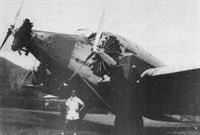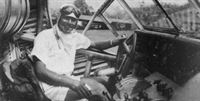Фотографии
-
Регистрационный номер: VH-UQX De Havilland D.H.50 VH-UQX, seen at Watut, New Guinea, in 1937 with Nev Bruckhauser in the cockpit, was powered by a Bristol Jupiter radial. The roof of the passenger cabin forward of the cockpit is opened for access.
Самолёты на фотографии: De Havilland D.H.50 - Великобритания - 1923
-
Регистрационный номер: VH-UNM [2] Junkers W34 VH-UNM of Guinea Airways at Port Moresby, Papua, in 1939. Mr Cannon recalls 8 that these machines, powered with 500 h.p. Pratt & Whitney radials, were “terrific”, and could carry a one-ton pay load as landplanes or 1,600lb as floatplanes.
Самолёты на фотографии: Junkers W 33 / W 34 / Ju.46 - Германия - 1926
-
Регистрационный номер: VH-UOX This Guinea Airways Junkers W34, VH-UOX, ground-looped at Slate Creek, New Guinea, in 1937, owing to a tail wind, ending up in the creek; hence the makeshift “undercarriage”.
Самолёты на фотографии: Junkers W 33 / W 34 / Ju.46 - Германия - 1926
-
Регистрационный номер: VH-UNM [2] Another shot of Junkers W34 VH-UNM at Port Moresby in 1939.
Самолёты на фотографии: Junkers W 33 / W 34 / Ju.46 - Германия - 1926
-
George Cannon poses with a Junkers G31 at Wau in 1937. Despite their crude-looking corrugated finish and boxy engine nacelles, the G31s were great workhorses. From the time they entered service in April 1931 until August 31, 1936, the three G31s made 5,701 trips, flew 586,147 miles, and carried 15,861 tons and 4,229 passengers.
Самолёты на фотографии: Junkers G 31 - Германия - 1926
-
Our contributor in the cockpit of a Junkers G31, New Guinea, 1936. Powered by a trio of Pratt & Whitney Hornet radials, the big G31 could carry a load of 6,000lb.
Самолёты на фотографии: Junkers G 31 - Германия - 1926
-
Another view of the G31 cockpit, showing the central console.
Самолёты на фотографии: Junkers G 31 - Германия - 1926
-
Регистрационный номер: G-ABEF Ford 4AT-E Trimotor G-ABEF Vagabond was purchased by Holdens Air Transport Ltd from British Air Navigation Co Ltd at Heston through W. S. Shackleton in June 1935, and became VH-UDY. Powered by three 300 h.p. Wright Whirlwinds, it was originally Ford’s demonstrator NC9678. It is seen at Salamaua, New Guinea, in 1936.
Самолёты на фотографии: Ford Tri-Motor / 4-AT / 5-AT - США - 1926
Статьи
- -
- de Havilland D.H.53 /Preservation Profile/ (68)
- News Spotlight
- Personal album
- Skywriters
- ??? - Beach's baby
- ??? - Finland's Super Tiger
- B.Gunston - Lockheed F-94 /Fighters of the fifties/ (21)
- B.Johnson - Carrier hang-ups
- J.Bruce - Austin's aggressor (2)
- M.Lambert - Rendezvous with Double Eagle
- M.Peden - The radar war (2)
- P.Heath - Routine training trip?
- R.Bravard - Alpine aviation
- R.Halley - Per Ardua ad India
- R.Riding - Cranwell C.L.A.4 /British pre-war ultralights/







